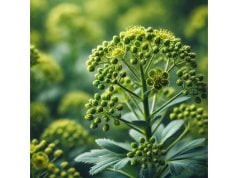Ginger is much more than a spice found in every kitchen; it is a time-honored herb celebrated for its potent healing properties and remarkable versatility. Revered across diverse cultures for centuries, ginger has proven benefits ranging from digestive relief to anti-inflammatory support. Its unique pungent flavor and aroma enrich culinary dishes while offering a natural remedy for nausea and muscle pain. In this comprehensive guide, we delve deep into ginger’s botanical characteristics, its powerhouse of active compounds, varied health benefits, diverse applications, and the science behind its acclaimed efficacy. Discover why ginger remains a staple in both traditional medicine and modern wellness routines.
Table of Contents
- Plant Characteristics & Identification
- Active Compounds & Chemical Profile
- Wellness Benefits & Healing Traits
- Applications, Safety, & Usage Tips
- Research Insights & Key Studies
- Frequently Asked Questions
Plant Characteristics & Identification
Ginger (Zingiber officinale) belongs to the Zingiberaceae family and is native to Southeast Asia. This herb is characterized by its distinctive underground rhizome, which is the primary part used for culinary and medicinal purposes. The ginger plant itself features narrow, green leaves that arise from a pseudostem, with subtle, yellowish flowers that bloom in clusters. Its robust, fibrous roots are encased in a papery skin, which, when peeled, reveal a pale yellow interior exuding a spicy, aromatic flavor.
Taxonomy and Botanical Description
- Kingdom: Plantae
- Clade: Angiosperms, Monocots
- Order: Zingiberales
- Family: Zingiberaceae
- Genus: Zingiber
- Species: Z. officinale
Ginger thrives in warm, humid climates and is typically cultivated in tropical regions. The plant prefers well-drained, loamy soils enriched with organic matter and flourishes under partial sunlight. Its fast-growing nature makes it an ideal crop for regions with ample rainfall and a long growing season. The rhizome, which is harvested once the plant reaches maturity, is not only prized for its culinary zest but is also extracted for essential oils and various therapeutic compounds.
Physical Attributes and Growth Habits
The ginger plant is unique in its growth pattern:
- Rhizome: The underground stem is fibrous and knotty. Its pungency and spice come from this very part, making it the focus of both culinary and medicinal preparations.
- Leaves: Long, narrow, and lance-shaped, the leaves form an elegant, arching canopy that supports the growth of the flowering structure.
- Flowers: The inflorescences of ginger are composed of delicate, trumpet-shaped blooms, usually tinged with yellow or orange, which add to the plant’s ornamental value.
- Stem: Ginger’s pseudostem is formed by tightly wrapped leaf sheaths that give the appearance of a single, continuous stalk.
Natural Habitat and Cultivation Practices
Ginger originally hails from the tropical climates of India and Southeast Asia. In its natural habitat, it grows as an understory plant in forested areas, benefitting from the filtered sunlight that penetrates the dense canopy. Modern agricultural practices have expanded its cultivation worldwide, from tropical regions to controlled greenhouse environments in temperate zones. Farmers often use organic farming methods to maintain soil health and to meet the increasing consumer demand for chemical-free produce.
Historical and Cultural Significance
Throughout history, ginger has played a pivotal role in traditional medicine systems such as Ayurveda and Traditional Chinese Medicine (TCM). Ancient texts refer to ginger as a warming herb used to stimulate digestion, improve circulation, and alleviate respiratory conditions. Its cultural importance is underscored by its frequent appearance in rituals, culinary traditions, and folk remedies, highlighting its integral role in human health and cultural practices across continents.
Identification in the Field
Identifying ginger in the wild or in a garden setting involves:
- Rhizome Inspection: The underground portion should appear knobby with a pale yellow to beige interior. Its firm, fibrous texture is a clear indicator of its quality.
- Leaf Pattern: The long, arching leaves with a vibrant green color are typical, though variations can occur based on soil fertility and climate.
- Flower Structure: Although less common in commercial cultivation, the small, clustered flowers offer a visual confirmation of the species, especially when the plant is left to bloom in a natural environment.
- Environmental Cues: A humid, shaded area with well-drained soil is a prime indicator of an ideal habitat for ginger, reinforcing the importance of environmental factors in its growth and quality.
Ginger’s adaptability and resilience have made it a favored crop among smallholder farmers and large-scale agricultural operations alike. Its ability to combat pests naturally and its relatively low maintenance requirements further contribute to its global popularity. Whether grown in traditional home gardens or in modern agricultural setups, ginger’s botanical features remain consistent, serving as a reliable marker for identification and quality assurance.
Active Compounds & Chemical Profile
Ginger is renowned for its potent bioactive constituents that contribute to its therapeutic benefits and distinctive flavor. Below is a list of the key active compounds found in ginger, along with an in-depth analysis of each component:
- Gingerol
Gingerol is the primary active compound in fresh ginger. It is responsible for the herb’s unique pungent taste and aroma. Chemically classified as a phenolic compound, gingerol exhibits potent anti-inflammatory and antioxidant properties. It plays a crucial role in reducing oxidative stress, thereby supporting immune function and protecting cells from damage. Researchers have noted that gingerol can modulate inflammatory pathways, making it beneficial for managing conditions such as arthritis and muscle soreness. - Shogaol
Formed during the drying or thermal processing of ginger, shogaol is a derivative of gingerol and is even more potent in its biological activities. Shogaol is known for its enhanced anti-inflammatory and anti-nausea effects. Its higher concentration in dried ginger makes this form particularly effective for alleviating symptoms of gastrointestinal discomfort. Studies suggest that shogaol may also possess anticancer properties, further bolstering ginger’s reputation as a natural remedy. - Zingerone
Zingerone is another important compound that emerges during the cooking or heating of ginger. It is less pungent than gingerol but offers significant antioxidant benefits. Zingerone’s ability to scavenge free radicals contributes to its protective effects against cellular damage. Additionally, it is recognized for its antimicrobial properties, which may help in preventing infections. This compound also plays a role in promoting digestive health by stimulating the secretion of digestive enzymes. - Paradols
Paradols are a group of compounds structurally related to gingerol and shogaol. They exhibit a range of pharmacological activities, including anti-inflammatory, antiemetic, and analgesic effects. Paradols contribute to ginger’s overall therapeutic profile by working synergistically with other bioactive constituents. Their presence enhances the herb’s ability to modulate pain and reduce inflammation, making them valuable in the treatment of various inflammatory conditions. - Bisabolene and Other Terpenoids
Ginger also contains sesquiterpenoids such as bisabolene, which contribute to its aroma and therapeutic effects. These compounds have been shown to possess anti-inflammatory and antimicrobial properties. Terpenoids in ginger work in tandem with phenolic compounds to enhance the herb’s overall efficacy. Their complex interactions contribute to the broad spectrum of ginger’s health benefits, from supporting immune function to protecting against microbial infections.
Chemical Synergy and Bioavailability
The combination of these compounds creates a synergistic effect, meaning that the collective benefits are often greater than the sum of the individual components. This synergy is one of the reasons why ginger is so effective as a natural remedy. Furthermore, the bioavailability of these compounds can be influenced by factors such as preparation method and dosage. For instance, fresh ginger contains higher levels of gingerol, while dried ginger is richer in shogaol, each offering unique benefits depending on the intended use.
Extraction and Standardization
In modern nutraceuticals, ginger extracts are often standardized to contain a specific percentage of gingerol or shogaol. This standardization ensures consistency in dosage and therapeutic effect. Various extraction methods, such as steam distillation and ethanol extraction, are employed to obtain high-quality extracts that preserve the integrity of these bioactive compounds. As research advances, the development of novel formulations aims to enhance the bioavailability and efficacy of ginger’s key constituents, paving the way for innovative applications in both medicine and nutrition.
Wellness Benefits & Healing Traits
Ginger’s multifaceted healing properties have cemented its reputation as a natural remedy for a broad array of health issues. Its active compounds work in unison to deliver benefits that span from digestive relief to enhanced immune function.
Digestive Health and Gastrointestinal Relief
Ginger is widely known for its ability to ease gastrointestinal discomfort. It helps to stimulate digestive juices and enzymes, which in turn improve the overall digestion process. Regular consumption of ginger can:
- Alleviate symptoms of indigestion
- Reduce bloating and gas
- Soothe an upset stomach
- Mitigate nausea caused by motion sickness, pregnancy, or chemotherapy
Clinical studies suggest that ginger’s anti-nausea effects are particularly pronounced in individuals suffering from morning sickness or undergoing medical treatments that induce nausea.
Anti-Inflammatory and Pain Relief
The potent anti-inflammatory properties of ginger make it an effective natural remedy for conditions characterized by chronic inflammation. Compounds such as gingerol and shogaol inhibit inflammatory markers and enzymes responsible for pain. This action can help reduce:
- Joint pain and stiffness associated with osteoarthritis
- Muscle soreness following strenuous exercise
- Inflammatory responses in conditions like rheumatoid arthritis
Regular intake of ginger, whether as a tea or supplement, has been linked to improvements in inflammatory conditions, ultimately leading to enhanced mobility and reduced discomfort.
Cardiovascular and Metabolic Support
Emerging research highlights ginger’s role in cardiovascular health. Its ability to lower blood pressure and improve blood circulation contributes to a reduced risk of heart-related ailments. Ginger is also recognized for its potential to:
- Lower cholesterol levels
- Enhance metabolic rate
- Regulate blood sugar levels
These metabolic benefits not only support heart health but also aid in weight management and the prevention of metabolic disorders such as type 2 diabetes.
Immune System Booster and Antioxidant Protection
Ginger’s robust antioxidant properties are instrumental in combating oxidative stress—a key factor in aging and chronic disease development. The bioactive compounds in ginger help to neutralize free radicals, thereby:
- Strengthening the immune system
- Reducing cellular damage
- Preventing the onset of degenerative diseases
Incorporating ginger into one’s daily diet may thus serve as an effective strategy for maintaining long-term health and vitality.
Neurological and Cognitive Benefits
Preliminary studies suggest that ginger might offer neuroprotective benefits. Its antioxidant and anti-inflammatory effects are believed to help protect brain cells from damage caused by oxidative stress and inflammation. Some research indicates that ginger may contribute to:
- Enhanced cognitive function
- Improved memory retention
- A potential reduction in the risk of neurodegenerative diseases
While more research is needed to fully understand these benefits, early findings offer promising insights into ginger’s role in supporting brain health.
Holistic Health and Overall Wellbeing
Beyond its specific therapeutic effects, ginger has long been valued as a holistic tonic that supports overall wellbeing. Its warming properties are believed to enhance circulation and promote a sense of comfort during cold seasons. Whether incorporated into meals, brewed into teas, or taken as supplements, ginger’s multifaceted benefits make it a cornerstone of natural health practices around the world.
Applications, Safety, & Usage Tips
Ginger’s versatility extends to a myriad of applications across culinary, medicinal, and cosmetic domains. Understanding the proper methods of use and safety considerations is essential for maximizing its benefits while minimizing potential risks.
Culinary and Nutritional Uses
Ginger is a culinary gem, celebrated for its ability to transform dishes with its unique flavor profile. It is used in:
- Spice Blends: Commonly added to curry powders, marinades, and rubs.
- Beverages: Brewed into teas, infused in lemonades, or blended into smoothies for a zesty kick.
- Baked Goods: Incorporated into cookies, cakes, and breads to enhance both aroma and taste.
- Pickles and Preserves: Fresh ginger is often used in pickling recipes to impart a tangy and spicy note.
The nutritional benefits of ginger, including vitamins, minerals, and antioxidants, complement its flavor, making it a popular ingredient in health-conscious recipes.
Medicinal Applications and Preparation Methods
In traditional medicine, ginger is primarily used to combat nausea, inflammation, and digestive issues. Here are some common preparation methods:
- Ginger Tea: Steep freshly sliced or grated ginger in hot water for 10–15 minutes. This infusion can alleviate nausea and improve digestion.
- Tinctures and Extracts: Concentrated forms of ginger are used in supplements to provide targeted relief for inflammation and pain.
- Powdered Ginger: Easily added to recipes or capsules, powdered ginger is a convenient alternative for daily consumption.
- Topical Applications: Ginger-infused oils and creams are used in massages to relieve muscle soreness and joint pain.
When preparing ginger, consider the form—fresh, dried, or powdered—as each delivers a different concentration of active compounds. Adjusting the preparation method based on the desired therapeutic effect is key to achieving optimal results.
Dosage Recommendations and Practical Tips
For most adults, a daily intake of 1–2 grams of ginger is considered safe and effective for general health benefits. However, dosages may vary based on individual health needs and the specific condition being addressed. Here are some practical guidelines:
- For Digestive Relief: Consume 1 gram of fresh ginger steeped in tea or incorporated into meals.
- For Inflammation and Pain: Supplements standardized for gingerol content may be taken as directed on product labels, typically in doses ranging from 500 mg to 1 gram per day.
- During Pregnancy: While ginger can alleviate morning sickness, it is advisable to consult a healthcare professional for appropriate dosage to ensure safety.
- For Athletes: Ginger may be consumed before or after workouts to reduce muscle soreness and enhance recovery.
Always start with a small dose, particularly if you are new to using ginger as a supplement, and observe how your body responds.
Safety Considerations and Potential Side Effects
Despite its numerous benefits, ginger may cause side effects in some individuals, including mild heartburn, diarrhea, or stomach discomfort, particularly when consumed in excessive amounts. People taking blood-thinning medications or those with gallstones should exercise caution due to ginger’s natural effects on blood flow and bile production. It is recommended to consult a healthcare provider before integrating high doses of ginger into your routine, especially if you have underlying health conditions or are pregnant.
Storage and Handling Recommendations
To preserve its potency, store fresh ginger in a cool, dry place or refrigerate it in a sealed container. Dried and powdered ginger should be kept in an airtight container away from direct sunlight. Proper storage not only maintains flavor but also ensures that the active compounds remain effective for therapeutic use.
Research Insights & Key Studies
The growing interest in ginger’s therapeutic properties has spurred a multitude of scientific studies aimed at validating its benefits. Below is a numbered list of significant studies, each accompanied by key findings and detailed insights:
- Study on Ginger’s Anti-Nausea Effects (2010)
Journal: Journal of Alternative and Complementary Medicine
This randomized controlled trial evaluated ginger’s efficacy in reducing nausea and vomiting in patients undergoing chemotherapy. The study concluded that a standardized dose of ginger significantly reduced nausea severity, providing a natural adjunct to conventional antiemetic therapies.
Researchers observed improvements in patients’ quality of life and noted a reduction in the need for additional medications. The study’s findings have encouraged further exploration into ginger’s role as a supportive treatment for chemotherapy-induced nausea, highlighting its potential as a safe, natural remedy. - Investigation of Anti-Inflammatory Properties (2012)
Journal: Journal of Ethnopharmacology
This study examined the anti-inflammatory effects of ginger extracts in patients suffering from osteoarthritis. Results demonstrated that daily consumption of ginger significantly reduced joint pain and inflammation.
The researchers attributed these effects to gingerol and shogaol, which modulate inflammatory mediators. The study provides compelling evidence for ginger as an effective natural alternative to conventional non-steroidal anti-inflammatory drugs (NSAIDs), encouraging its integration into pain management strategies for inflammatory conditions. - Digestive Health and Gastric Motility Research (2014)
Journal: World Journal of Gastroenterology
Focused on ginger’s impact on gastrointestinal function, this research explored its ability to enhance gastric motility and alleviate dyspepsia. The findings revealed that ginger supplementation improved digestive efficiency and reduced symptoms such as bloating and indigestion.
The study’s controlled design and robust methodology lend strong support to ginger’s traditional use as a digestive aid. It further underscores the herb’s versatility in addressing common gastrointestinal issues through natural means. - Cardiovascular Benefits and Lipid Profile Improvement (2016)
Journal: Journal of Medicinal Food
This clinical trial investigated ginger’s potential to improve cardiovascular health by lowering cholesterol levels and enhancing blood circulation. Participants who consumed ginger supplements experienced notable reductions in low-density lipoprotein (LDL) cholesterol and improvements in overall vascular function.
The research provided valuable insights into how ginger’s bioactive compounds can contribute to heart health by mitigating risk factors associated with cardiovascular disease. Its findings support the inclusion of ginger in dietary regimens aimed at preventing heart-related ailments. - Antioxidant Capacity and Cellular Protection Study (2018)
Journal: Phytotherapy Research
Aimed at quantifying ginger’s antioxidant properties, this study measured the herb’s ability to neutralize free radicals and protect cells from oxidative stress. The results indicated that ginger extract, rich in gingerol and zingerone, significantly enhanced antioxidant defenses, potentially reducing the risk of chronic diseases.
The study not only confirmed ginger’s role as a potent antioxidant but also opened avenues for future research into its application in preventing degenerative diseases. It underscores the importance of incorporating natural antioxidants into daily nutrition for long-term health benefits.
Frequently Asked Questions
What are the primary health benefits of ginger?
Ginger is widely recognized for its digestive support, anti-inflammatory effects, and ability to alleviate nausea. Its potent bioactive compounds help reduce muscle soreness and joint pain while enhancing immune function and promoting overall wellness.
How can ginger be safely incorporated into a daily routine?
Ginger can be enjoyed in various forms such as fresh slices, teas, or supplements. It is generally safe when consumed in moderate amounts; however, it is important to start with small doses and consult a healthcare provider if you are taking medications or are pregnant.
Are there any potential side effects from consuming ginger?
Some individuals may experience mild heartburn, stomach discomfort, or diarrhea when consuming ginger in large quantities. Those on blood-thinning medications or with gallstone issues should exercise caution and consult with a medical professional before use.
What forms of ginger are most effective for therapeutic use?
Fresh ginger is ideal for retaining high levels of gingerol, while dried ginger, which is richer in shogaol, may be more effective for nausea and inflammation. The choice depends on your specific health goals and culinary preferences.
Can ginger help with weight management and metabolism?
Preliminary studies suggest that ginger may support metabolic health by improving digestion and enhancing fat oxidation. While it can be a beneficial component of a balanced diet, it should be combined with regular exercise and proper nutrition for optimal weight management.
Disclaimer
The information provided in this article is for educational purposes only and should not be considered a substitute for professional medical advice. Always consult with a healthcare professional before making any significant changes to your diet or health regimen.
If you found this article helpful, please consider sharing it on Facebook, X (formerly Twitter), or your preferred social platform to help spread the knowledge about ginger’s incredible benefits!

















